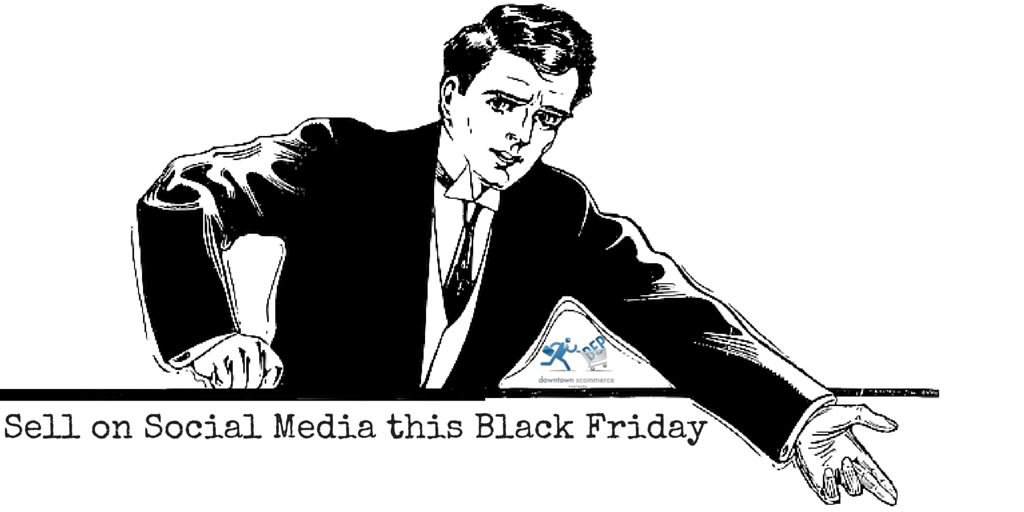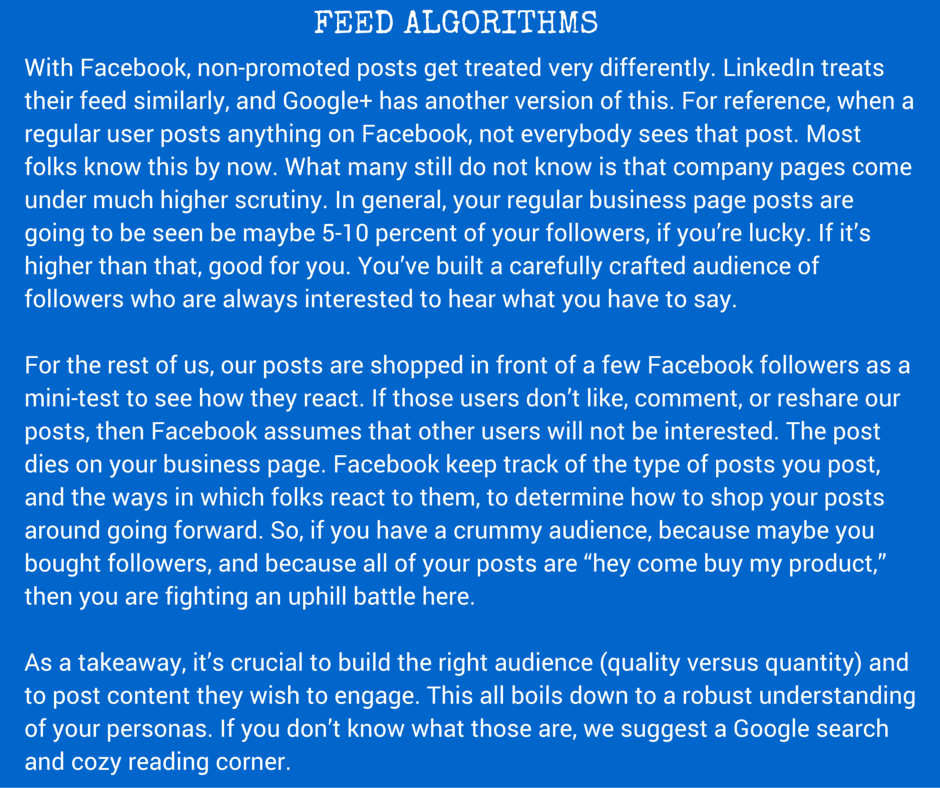Blog
Sell on Social Media this Black Friday
 As we close in on the trifecta of commerce for 2015, Black Friday, Small Biz Saturday, and Cyber Monday, many retailers are anxious about how well they’ll do in the coming weeks. It’s enough to make you want to run out and beat up Santa. For what it’s worth, we don’t recommend this.
As we close in on the trifecta of commerce for 2015, Black Friday, Small Biz Saturday, and Cyber Monday, many retailers are anxious about how well they’ll do in the coming weeks. It’s enough to make you want to run out and beat up Santa. For what it’s worth, we don’t recommend this.
What we also don’t recommend is blowing up your follower’s feeds with pitchy posts between now and Cyber Monday. That said, with good planning, you could and should try to increase your sales through social media channels. The artistry of this strategy is buried in understanding a little about the algorithms that dictate the respective feeds. Translation: you gotta understand the feed, man.
Most of the ecommerce owners with whom we work tend to favor Facebook, so for simplicity’s sake we will stick mostly to that platform, but as often as possible we will speak to other channels and how this work may or may not translate there. You should be selling where your buyers are, or as I like to say, fish where the fish are.
There are two ways you can sell on social media. You can hock products in a very traditional manner, or you can subtly pitch the value of your brand through engaging content. Neither one is more correct than the other, but the best in social media do both well. The key is to understand a little about the way shared content is received by the various audiences you may have in your social media channels.
Furthermore, in most cases you can pay for others to see your sales pitch, or you can rely on the course of nature to put your post in front of others. Because of this, the concept of how you sell breaks up into four categories as we see it.
- Sell products via ads
- Sell products via posts
- Sell brand via ads
- Sell brand via posts
For simplicity, in this blog ads are paid for, posts are not.
The sooner you see all of your posts and ads as part of a long-winded sales pitch, the sooner you will connect the value of the time you spend posting. Like the plot points of a story, if your posts aren’t driving your sales story, then why are you posting them?

Sell Products Via Ads

Examples
- Promoted content regarding a promotion or sale.
- Promoted content regarding a new product to the market
This is the most traditional selling model in the social media world. It requires copy, a good image, and a target audience.
The difference between paid social ads and paid search ads, is that social media networks own psychographic data about their users, and your potential audience. They aren’t going to give you access to the information they have, not directly, but they can better target your ads to the personas you wish to reach based what you tell them. In the case of Facebook, you can get very specific.
The best thing about paying for your content is there is no need to be apologetic. Users have come to expect a certain number of ads in their feeds, and they either choose to ignore them, or they click on them. You’re obviously hoping for the latter.
Sell Products Via Posts

Examples
- Non-Promoted announcement of a promotion or sale
- Non-Promoted announcement of new product to the market
While users do expect a certain number of ads in their feeds, and will tolerate even bad pitches to a certain extent, they will not tolerate brands selling via non-promoted posts. If your Facebook posts consists of browbeating users with message that sound like “buy, buy, buy!” you can expect one outcome for sure: decreased engagement. You may also lose followers.
In fact, it probably won’t be tolerated if you merely hint at buy-anything in your posts. While Facebook users have come to tolerate ads in their feed, they have not come to welcome them. The unwritten law is that business are fine to buy ads, but they’d better not sneak them into regular posts.
Pushing pitches, even really subtle clever ones into your regular posting schedule makes you the ambulance chaser of social media. It’s overt opportunism.
These posts do little to push the plot points of your brand’s story anyway. They only serve to demonstrate self-serving behavior on behalf of the larger entity which is your brand.
Even worse, your actual penetration of your audiences will drop exponentially.
Sell Brand Via Ads

Examples:
- Promoted posts that drive followers
- Promoted brand awareness posts
While in theory this all sounds lovely, we say proceed with caution. Your best intentions may cost you more than what you get out of this strategy.
In most sales, if you are paying for ad space, then you are probably hocking products or services. Occasionally, brands try to sell their brand for awareness, like when they’re just getting started, or need to build up to a promotion of some sort. This is all fine, and should be part of a larger marketing plan for brand awareness.
For smaller ecommerce outfits, we don’t generally recommend this strategy. It’s too difficult to attach an ROI to the spend, and your promoted content may attract zombie followers. These are users who follow any brand which cycles through their feed, or worse, users who really are bots paid to click ads. Both are engagement killers.
Sell Brand Via Posts

Examples
- News that impacts your followers
- Post promoting causes that your brand supports
- Internal videos that familiarizes followers with your organization
This should be 75-90% of your posts on Social Media. As long as your posts do not literally say “how awesome is our brand?” then you can sell your brand subtly on social media all day long. In fact, if you really have a cool brand you can get away with “how awesome is our brand” once in awhile. If your brand is one that users feel proud to be associated with, they may dig it. (Think Apple)
As a stronger strategy for selling your brand, you will go further with copy and imaging which shows that you are cool, rather than tells that you are cool. If you really are good, the users will tell everyone for you.
You still have time to put some effort into this year’s Trifecta of commerce, but if you haven’t started telling the story of your brand yet, you may want to adjust your expectations. Take out a calendar and count the days until Black Friday. Consider your audience, and what helpful posts you can provide them.
For promoted content, my favorite idea is some simple buying guides, with images and pricing.
For regular posts, any kind of helpful information you can provide is going to go a long way. If your product is outdoor goods, posts tips on picking the right gear for your winter outing. If you sell kitchenware, post a side by side comparison of selecting aluminum versus cast iron.
If you are still lost and want help, contact us. We would love to help you.
–Damon Mitchell | Director of Social Media
Categorised in: Social Media
This post was written by downtownecommerce_admin
